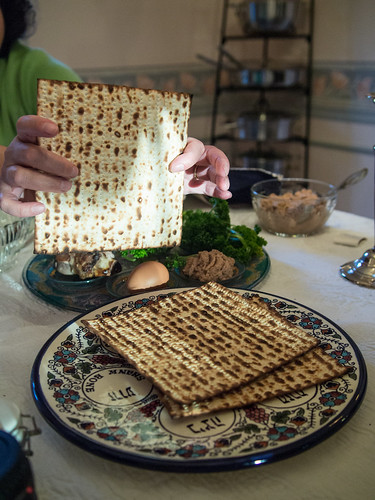My mother always said that you should clean the house once a year whether it needs it or not. I’m not quite that bad (neither was she), though I do consider a dust-free home to be a sign of misplaced priorities. When I do engage in a major bout of housekeeping, I always remember the year I spent in Israel. Preparing for Passover involved a level of spring cleaning the likes of which I had never seen before.
Passover is a week long celebration in which Jews commemorate being freed from slavery in ancient Egypt. The holiday begins with a ritual feast known as the Passover Seder. As an outsider invited to my first Seder, I was struck by how integrated the various aspects of the celebration were. Toasts are made (four cups of wine) and symbolic foods eaten while the story of the Exodus is retold. During Passover, Jews are not allowed to eat leavened bread (no time to wait for the bread to rise when you are fleeing slavery). Instead they make a million different dishes using matza – unleavened flat bread.
Pulled away from farm duties to help the matriarch of the family I worked for with the housework, we set about cleaning the kitchen. Ensuring that there was not a trace of leaven meant pulling everything out of every cupboard and wiping them down. Then we cleaned the oven and pulled it and the refrigerator (recently cleaned and defrosted) away from the wall to wash under and behind them. I thought our work would be done after this thorough kitchen scrubbing, but Etti announced that next we would be repainting the inside of the house.
“You repaint the house every year?” I asked.
“Yes,” she said, and proceeded to tell me about a time when she was sixteen and her mother was in the hospital during Passover. She and her younger sister had taken on the painting themselves.
Finally, I could no longer contain the puzzlement I’d been feeling. “Etti, this seems crazy. To celebrate that you are free, you must work like a slave.”
She smiled and nodded. “Yes. We say it is the joke of destiny.”
What’s on a Seder Plate?• Matza (on a separate plate) • Bitter herbs (lettuce or horseradish) symbolizing the bitterness of slavery • A fruit and nut paste which represents the mortar used by Jewish slaves building in Egypt • A vegetable other than bitter herbs (parsley, celery or potato) dipped in salt water which represents the tears of shed during years of enslavement • A lamb shank bone as a reminder the Isrealites using lamb’s blood to mark their doors during the tenth plague in Egypt • A hard boiled egg as a symbol of mourning for the loss of the two Temple of Jerusalem • An orange is sometimes added as a symbol of solidarity with marginalized populations within mainstream Jewish tradition (gays, lesbians, feminists) | |
The post Passover and the Joke of Destiny appeared first on Gear Up and Play.
Passover and the Joke of Destiny



Комментариев нет:
Отправить комментарий